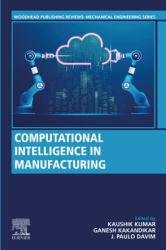Computational Intelligence in Manufacturing (2022)
- Добавил: literator
- Дата: 11-11-2022, 02:05
- Комментариев: 0
 Название: Computational Intelligence in Manufacturing
Название: Computational Intelligence in ManufacturingАвтор: Kaushik Kumar, Ganesh M. Kakandikar
Издательство: Woodhead Publishing/Elsevier
Год: 2022
Страниц: 226
Язык: английский
Формат: pdf (true)
Размер: 16.8 MB
Computational Intelligence in Manufacturing addresses applications of Artificial Intelligence (AI), Machine Learning and other innovative computational techniques across the manufacturing supply chain. The rapid development of smart or digital manufacturing known as Industry 4.0 has swiftly provided a large number of opportunities for product and manufacturing process improvement. Selecting the appropriate technologies and combining them successfully is a challenge this book helps readers overcome . It explains how to prepare different manufacturing cells for flexibility and enhanced productivity with better supply chain management, e.g., calibrating design machine tools for automation and agility.
Computational Intelligence (CI) applications for non-conventional manufacturing processes such as ECM and EDM are covered alongside recent advances in traditional processes like casting, welding and metal forming. As well as describing specific applications, this practical guide also explains the computational intelligence paradigm for enhanced supply chain management.
Computational Intelligence is often confused or interchangeably used with Artificial Intelligence; however, they both are distinct yet similar. As the
disciple of AI concentrates on studying the intelligent behavior of the machines and not human beings’ natural intelligence, CI, on the other hand, is the study incorporating flexibility of the systems to develop intelligent systems within changing environments. The aim of AI is to develop intelligent systems which showcase intelligent behavior and learn like humans, while the goal of CI is to gauge the computational paradigms existing to enable intelligent behavior in both natural and artificial systems within complex and changing surroundings. Some of the applications of AI used commonly are speech recognition, handwriting recognition, character recognition, machine vision, Big Data solutions, and many more. Some applications of CI much used are smart household appliances, banking optimization, industrial applications, medical diagnosis, and so on.
Artificial neural network (ANN): A feed-forward back-propagation (FFBP) neural network consists of an input layer, an output layer, and one or more hidden layers depending on the dataset. In the FFBP network, the input data are segregated into training, testing, and validation data. The input is fed to the hidden layer and through the weighting function. The output of each hidden layer acts as an input to the next layer. The error in each layer is calculated and propagated back to the previous layers for corrections where the weights are adjusted accordingly. In the FFBP network, each processing unit in the output layer produces a single real number as its output, which is compared with the targeted output specified in the training set. This process is repeated until the weights of the first hidden layer are all adjusted.
Скачать Computational Intelligence in Manufacturing
Внимание
Уважаемый посетитель, Вы зашли на сайт как незарегистрированный пользователь.
Мы рекомендуем Вам зарегистрироваться либо войти на сайт под своим именем.
Уважаемый посетитель, Вы зашли на сайт как незарегистрированный пользователь.
Мы рекомендуем Вам зарегистрироваться либо войти на сайт под своим именем.
Информация
Посетители, находящиеся в группе Гости, не могут оставлять комментарии к данной публикации.
Посетители, находящиеся в группе Гости, не могут оставлять комментарии к данной публикации.
